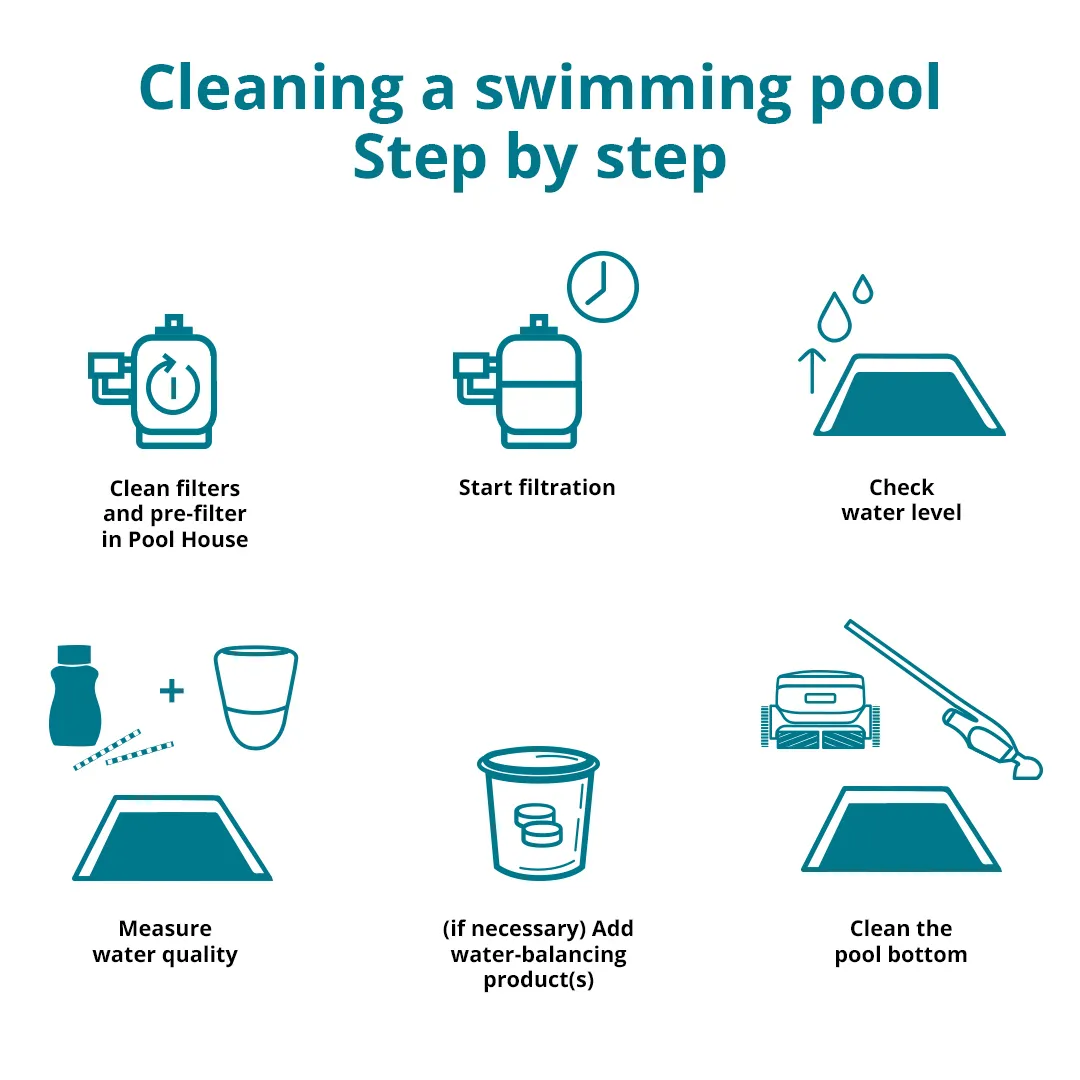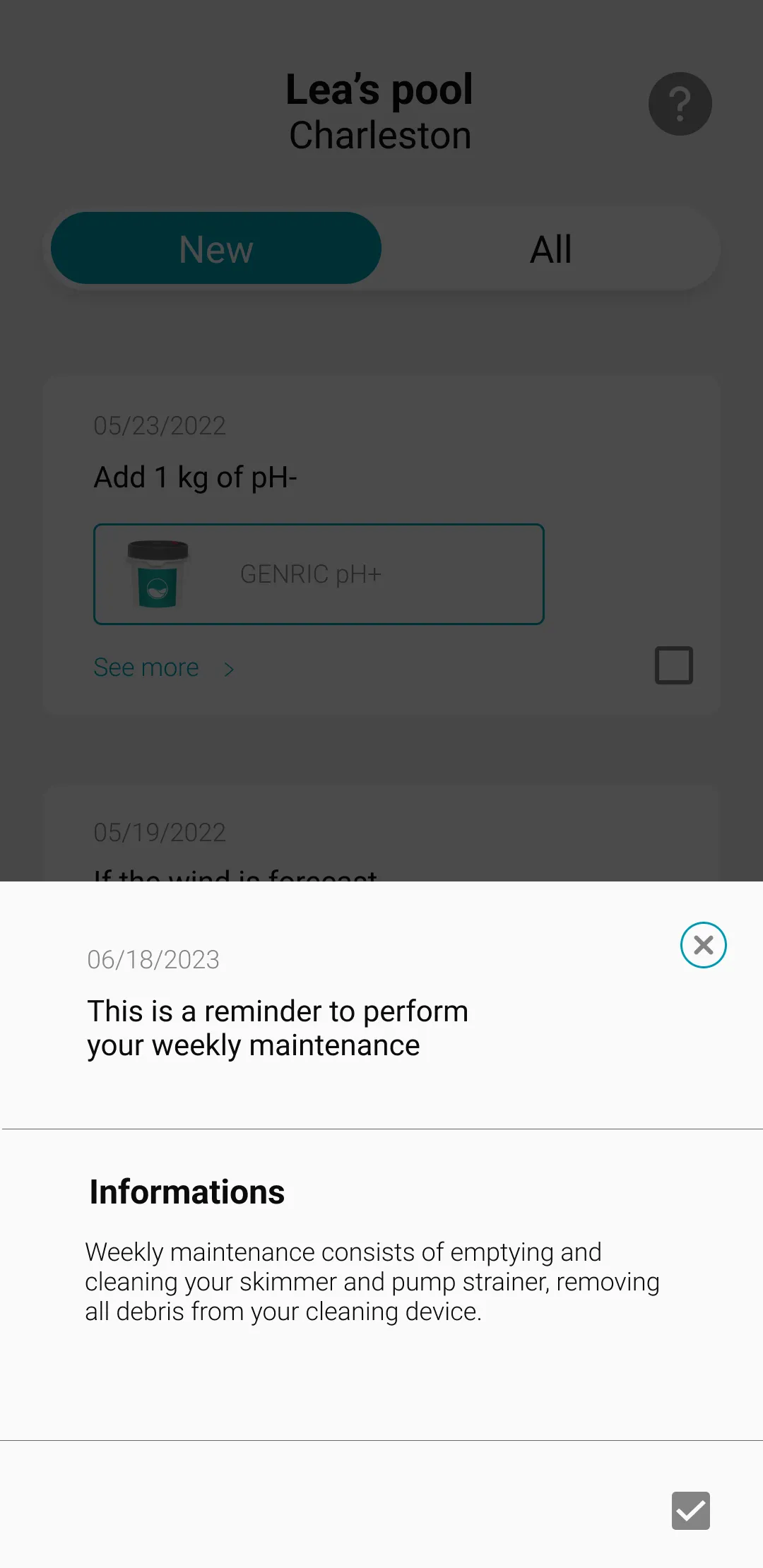Regular cleaning and maintenance of your pool keeps the water clean and healthy, and helps you preserve your equipment over the long term. In this article, you'll find all the tips and tricks you need to adopt the right routine.

When we talk about cleaning your pool, we distinguish between water surface cleaning (to be done daily in high season to remove leaves and insects) and weekly maintenance. The latter - more in-depth - concerns the water line, bottom and walls, which also need to be maintained on a very regular basis. By adopting a weekly routine (or more, depending on the number of bathers), you're acting upstream before the water deteriorates too much. The advantages of regular pool cleaning are obvious: less stress, fewer chemicals and real savings on your budget. On average, you only need 30 minutes of maintenance each week to keep your water crystal-clear. All you have to do is enjoy your swimming!
In off-season, to prepare for active or passive winterizing of your pool, specific cleaning is required to protect your equipment from freezing.
To keep your water healthy, you need to clean its surface daily of small impurities (insects, leaves) before they sink to the bottom. This will also limit clogging of your filter. To do this, use a telescopic landing net.
Define a maintenance day in the week and set aside 15 and 30 minutes to devote to your pool.

Start by cleaning the pump's pre-filter after closing the valves. Then turn on water filtration according to your pool's water temperature.
Check the water level, which should be 2/3 of the way up the skimmer. Adjust if necessary. If you don't use a pH tester for water quality, it's very important to check at least once a week that the water is balanced. To do this :
There are several systems available to help you clean the bottom of your pool. In addition to weekly maintenance, you'll need to do a thorough cleaning before restarting or winterizing your pool.
Automatic cleaning : the advantage of a vacuum cleaner (hydraulic, pressure or automatic) is of course its autonomy and time savings! Depending on the model of your robot, the bottom of the pool is normally cleaned perfectly, while corners and edges often need to be brushed manually.
Manual cleaning : The vacuum broom (venturi broom) cleans the bottom of your pool while sucking dirt into the hose. The classic broom requires more time and elbow grease, and a landing net for the dirt, but it's a tried-and-tested method.
Tiled pool : to clean the bottom, use a brush or vacuum cleaner for larger surfaces. A more thorough cleaning is required when restarting your pool, using a high-pressure water jet such as a Karcher.
The skimmer acts as a pre-filter before the water is drawn into the pump. It retains large impurities floating on the surface of the water. Regular maintenance is very important, because when the basket becomes blocked, the water no longer flows correctly to the filter pump, and the entire water filtration mechanism suffers.
For manual cleaning, use a brush or magic sponge. For dirt that doesn't come off easily, there are special products for cleaning walls, or silver stone, which is effective against black stains. Some robots also clean walls, but this more expensive solution won't completely dispense with manual brushing, especially in corners and nooks.
However, avoid rubbing the walls too hard, especially if your liner covers the whole pool, as this could eventually damage it. Test in an inconspicuous area to find the right material, or ask your supplier for advice.
For salt water pools, regularly check that the cell is clean. Clean it if necessary. Finally, regular maintenance of the protective grille and heat pump fan is essential. Use a soft brush to remove impurities.
There are a number of manual and automated tools available for cleaning the bottom of your pool. Whatever the method, they are essential for regular pool maintenance.
ICO Pool simplifies pool maintenance with automatic hourly water analysis. The tool features advanced functions such as maintenance day setting and personalized treatment recommendations.

| Cookie | Duration | Description |
|---|---|---|
| cookielawinfo-checkbox-analytics | 11 months | This cookie is set by GDPR Cookie Consent plugin. The cookie is used to store the user consent for the cookies in the category "Analytics". |
| cookielawinfo-checkbox-functional | 11 months | The cookie is set by GDPR cookie consent to record the user consent for the cookies in the category "Functional". |
| cookielawinfo-checkbox-necessary | 11 months | This cookie is set by GDPR Cookie Consent plugin. The cookies is used to store the user consent for the cookies in the category "Necessary". |
| cookielawinfo-checkbox-others | 11 months | This cookie is set by GDPR Cookie Consent plugin. The cookie is used to store the user consent for the cookies in the category "Other. |
| cookielawinfo-checkbox-performance | 11 months | This cookie is set by GDPR Cookie Consent plugin. The cookie is used to store the user consent for the cookies in the category "Performance". |
| viewed_cookie_policy | 11 months | The cookie is set by the GDPR Cookie Consent plugin and is used to store whether or not user has consented to the use of cookies. It does not store any personal data. |